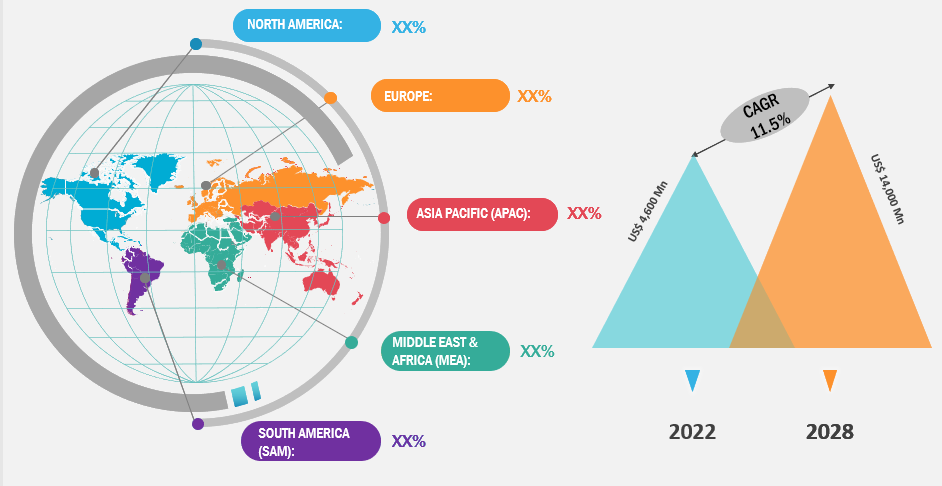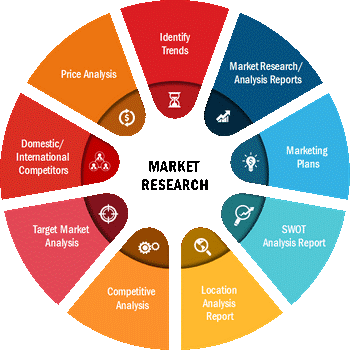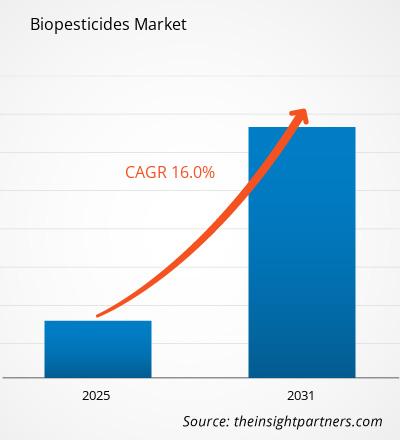Il mercato dei biopesticidi è stato valutato 4.600 milioni di dollari nel 2022 e si stima che crescerà a un ritmo CAGR dell'11,5% dal 2022 al 2031.
Biopesticidi possono essere derivati da animali, piante, batteri, alcuni minerali e altri materiali naturali. I biopesticidi vengono estratti da due fonti principali: biochimica e microbica. I pesticidi biochimici sono sostanze presenti in natura che controllano i parassiti mediante un meccanismo non tossico. Tuttavia, i pesticidi microbici sono costituiti da microrganismi, inclusi batteri, funghi e virus, come ingrediente attivo. I biopesticidi sono preferiti rispetto ai pesticidi convenzionali a causa della bassa tossicità. Inoltre, si decompongono facilmente, il che si traduce in una minore esposizione all'atmosfera e aiuta a evitare problemi di inquinamento. Questo parametro rafforza la crescita del mercato dei biopesticidi.
DINAMICHE DEL MERCATO
La crescita del mercato dei biopesticidi è principalmente guidata dal crescente utilizzo di biofertilizzanti nella produzione di cereali, semi oleosi e legumi, frutta e verdura. I biopesticidi sono altamente preferiti nei paesi sviluppati a causa delle rigorose norme governative relative all’inquinamento causato da sostanze chimiche dannose. In termini di modalità di applicazione, il segmento degli spray fogliari domina il mercato dei biopesticidi. Lo spray fogliare aiuta le piante ad assorbire più acqua, minerali e sostanze nutritive. La gestione dei biopesticidi è diventata facile per gli agricoltori grazie allo spray fogliare senza alcun rischio di ustioni chimiche. Vi è una crescente consapevolezza tra i consumatori riguardo all’uso dei biopesticidi nella produzione agricola senza che rimangano residui chimici dopo il processo. Lo spostamento della preferenza dei consumatori verso i prodotti biologici per condurre una vita sana ha costretto gli agricoltori ad adottare metodi agricoli sostenibili. Tutti questi fattori stanno alimentando la crescita del mercato dei biopesticidi.
MERCATO SCOPO
Il rapporto "Previsioni del mercato globale dei biopesticidi fino al 2031" mira a fornire una panoramica del mercato dei biopesticidi con una segmentazione dettagliata del mercato in base a tipo, fonte, modalità di applicazione e tipo di coltura. Il rapporto fornisce statistiche chiave basate sulla performance finanziaria dei principali attori. Offre inoltre tendenze e opportunità chiave nel mercato.
Strategico Approfondimenti
SEGMENTAZIONE DEL MERCATO
Il mercato globale dei biopesticidi è segmentato in base al tipo, alla fonte, alla modalità di applicazione e tipo di coltura. In base alla tipologia, il mercato è segmentato in bioinsetticidi, biofungicidi, bionematocidi e bioerbicidi. Per fonte, il mercato è segmentato in microbici, biochimici e altri. In base alla modalità di applicazione, il mercato globale dei biopesticidi è segmentato in trattamento delle sementi, suolo trattamento, spray fogliare e altri. In base al tipo di coltura, il mercato è segmentato in cereali, semi oleosi e legumi, frutta e verdura e altri.
Il mercato globale dei biopesticidi è segmentato in cinque regioni principali: Nord America, Europa, Asia-Pacifico (APAC), Medio Oriente e Asia. Africa (MEA) e Sud America. Il rapporto copre un'analisi e previsioni di 18 paesi in tutto il mondo insieme alle tendenze e alle opportunità prevalenti nella regione.
Dal punto di vista regionale, il Nord America ha dominato il mercato dei biopesticidi con una quota di circa il 35% nel 2021. La crescita del mercato nella regione è principalmente guidata dalla presenza di un gran numero di produttori di biopesticidi e dall'elevata tasso di adozione dei biopesticidi. Syngenta; Marrone Bio Innovations, Inc.; Bayer AG; Novozymes A/S; e Certis USA LLC sono tra i principali produttori di biopesticidi nella regione. Questi fornitori testimoniano una domanda costante da parte del settore agricolo. La figura seguente mostra il trend di crescita dei ricavi nel mercato dei biopesticidi in Nord America:
 Fonte: analisi dei partner Insight< /p>
Fonte: analisi dei partner Insight< /p>
Il rapporto analizza fattori quali fattori trainanti, restrizioni, opportunità e tendenze future, che influiscono il mercato dei biopesticidi. Fornisce inoltre un'analisi esaustiva delle cinque forze di Porter dei fattori che influenzano il mercato.
IMPATTO DELLA PANDEMIA DA COVID-19
A causa degli effetti dell’epidemia di COVID-19, la domanda di fertilizzanti è diminuita a livello globale. Inoltre, i produttori agricoli hanno registrato volumi di ordini significativamente inferiori a causa delle attività agricole limitate che escludono i prodotti essenziali. La produzione di fertilizzanti è stata ostacolata a causa dell’arresto delle attività produttive, creando un enorme divario tra domanda e offerta nel mercato dei fertilizzanti. Tuttavia, dal 2021, l’industria dei fertilizzanti è in forte crescita e si prevede che il trend di crescita continui nel corso degli anni. Ciò stimolerebbe il consumo di biopesticidi durante il periodo di previsione.
ATTORI DEL MERCATO
I rapporti coprono gli sviluppi chiave nel campo dei biopesticidi mercato. Diverse aziende si stanno concentrando su strategie di crescita organica, come lanci di prodotti, approvazioni di prodotti, brevetti ed eventi. Inoltre, acquisizioni e partnership & le collaborazioni sono tra le attività strategiche di crescita inorganica testimoniate nel mercato. Queste attività hanno aperto la strada all'espansione del business e della base clienti degli operatori del mercato. Si prevede che gli attori che operano nel mercato dei biopesticidi sperimenteranno opportunità di crescita redditizie in futuro grazie alla crescente domanda di biopesticidi.
Il rapporto include anche i profili delle principali società del mercato dei biopesticidi, insieme alle loro analisi SWOT e strategie di mercato. Inoltre, si concentra sui principali operatori del settore. profili aziendali, componenti e servizi offerti, informazioni finanziarie degli ultimi tre anni e sviluppi chiave negli ultimi cinque anni. Di seguito è riportato l'elenco di alcune aziende impegnate nel mercato dei biopesticidi.
- BASF SE
- Syngenta
- Marrone Bio Innovations, Inc.
- Bayer AG
- Novozymes A/S
- Certis USA LLC
- Andermatt Group AG.
- Nufarm
- MaxEEma Biotech Private Limited
- Greenwell Biotech
Il team di ricerca e analisi dedicato del partner Insight è composto da professionisti esperti con competenze statistiche avanzate e offre varie opzioni di personalizzazione nello studio esistente.

- Analisi storica (2 anni), anno base, previsione (7 anni) con CAGR
- Analisi PEST e SWOT
- Valore/volume delle dimensioni del mercato - Globale, regionale, nazionale
- Industria e panorama competitivo
- Set di dati Excel


- Visualization and 3D Rendering Software Market
- Joint Pain Injection Market
- Molecular Diagnostics Market
- Water Pipeline Leak Detection System Market
- Smart Grid Sensors Market
- Airline Ancillary Services Market
- Volumetric Video Market
- Gas Engine Market
- Sandwich Panel Market
- Print Management Software Market

Report Coverage
Revenue forecast, Company Analysis, Industry landscape, Growth factors, and Trends

Segment Covered
This text is related
to segments covered.

Regional Scope
North America, Europe, Asia Pacific, Middle East & Africa, South & Central America

Country Scope
This text is related
to country scope.
Domande frequenti
Based on geography, North America held the largest share of the biopesticides market due to the increasing adoption of sustainable agricultural practices, growing demand for organic food, and strict regulations on synthetic pesticides.
The shift towards microbial biopesticides is expected to be the key market trends.
Growing concerns over chemical pesticide residues is driving the market growth.
BASF SE; Syngenta; Bayer AG; Certis USA L.L.C.; Nufarm UK; Novozymes A/S; Andermatt Group AG; Koppert B.V.; Sumitomo Chemical; and ORO AGRI Europe are some of the key players operating in the biopesticides market
Based on type, the bioinsecticides segment is expected to witness the fastest growth during the forecast period
The Biopesticides Market is estimated to witness a CAGR of 16% from 2023 to 2031
Trends and growth analysis reports related to Chemicals and Materials : READ MORE..
The List of Companies
1. BASF SE
2. Bayer AG
3. Syngenta AG
4. Certis USA L.L.C.
5. FMC Corporation
6. Isagro Group
7. Koppert Biological Systems
8. BIOBEST GROUP NV
9. Marrone Bio Innovations
10. Novozymes A/S
The Insight Partners performs research in 4 major stages: Data Collection & Secondary Research, Primary Research, Data Analysis and Data Triangulation & Final Review.
- Data Collection and Secondary Research:
As a market research and consulting firm operating from a decade, we have published and advised several client across the globe. First step for any study will start with an assessment of currently available data and insights from existing reports. Further, historical and current market information is collected from Investor Presentations, Annual Reports, SEC Filings, etc., and other information related to company’s performance and market positioning are gathered from Paid Databases (Factiva, Hoovers, and Reuters) and various other publications available in public domain.
Several associations trade associates, technical forums, institutes, societies and organization are accessed to gain technical as well as market related insights through their publications such as research papers, blogs and press releases related to the studies are referred to get cues about the market. Further, white papers, journals, magazines, and other news articles published in last 3 years are scrutinized and analyzed to understand the current market trends.
- Primary Research:
The primarily interview analysis comprise of data obtained from industry participants interview and answers to survey questions gathered by in-house primary team.
For primary research, interviews are conducted with industry experts/CEOs/Marketing Managers/VPs/Subject Matter Experts from both demand and supply side to get a 360-degree view of the market. The primary team conducts several interviews based on the complexity of the markets to understand the various market trends and dynamics which makes research more credible and precise.
A typical research interview fulfils the following functions:
- Provides first-hand information on the market size, market trends, growth trends, competitive landscape, and outlook
- Validates and strengthens in-house secondary research findings
- Develops the analysis team’s expertise and market understanding
Primary research involves email interactions and telephone interviews for each market, category, segment, and sub-segment across geographies. The participants who typically take part in such a process include, but are not limited to:
- Industry participants: VPs, business development managers, market intelligence managers and national sales managers
- Outside experts: Valuation experts, research analysts and key opinion leaders specializing in the electronics and semiconductor industry.
Below is the breakup of our primary respondents by company, designation, and region:

Once we receive the confirmation from primary research sources or primary respondents, we finalize the base year market estimation and forecast the data as per the macroeconomic and microeconomic factors assessed during data collection.
- Data Analysis:
Once data is validated through both secondary as well as primary respondents, we finalize the market estimations by hypothesis formulation and factor analysis at regional and country level.
- Macro-Economic Factor Analysis:
We analyse macroeconomic indicators such the gross domestic product (GDP), increase in the demand for goods and services across industries, technological advancement, regional economic growth, governmental policies, the influence of COVID-19, PEST analysis, and other aspects. This analysis aids in setting benchmarks for various nations/regions and approximating market splits. Additionally, the general trend of the aforementioned components aid in determining the market's development possibilities.
- Country Level Data:
Various factors that are especially aligned to the country are taken into account to determine the market size for a certain area and country, including the presence of vendors, such as headquarters and offices, the country's GDP, demand patterns, and industry growth. To comprehend the market dynamics for the nation, a number of growth variables, inhibitors, application areas, and current market trends are researched. The aforementioned elements aid in determining the country's overall market's growth potential.
- Company Profile:
The “Table of Contents” is formulated by listing and analyzing more than 25 - 30 companies operating in the market ecosystem across geographies. However, we profile only 10 companies as a standard practice in our syndicate reports. These 10 companies comprise leading, emerging, and regional players. Nonetheless, our analysis is not restricted to the 10 listed companies, we also analyze other companies present in the market to develop a holistic view and understand the prevailing trends. The “Company Profiles” section in the report covers key facts, business description, products & services, financial information, SWOT analysis, and key developments. The financial information presented is extracted from the annual reports and official documents of the publicly listed companies. Upon collecting the information for the sections of respective companies, we verify them via various primary sources and then compile the data in respective company profiles. The company level information helps us in deriving the base number as well as in forecasting the market size.
- Developing Base Number:
Aggregation of sales statistics (2020-2022) and macro-economic factor, and other secondary and primary research insights are utilized to arrive at base number and related market shares for 2022. The data gaps are identified in this step and relevant market data is analyzed, collected from paid primary interviews or databases. On finalizing the base year market size, forecasts are developed on the basis of macro-economic, industry and market growth factors and company level analysis.
- Data Triangulation and Final Review:
The market findings and base year market size calculations are validated from supply as well as demand side. Demand side validations are based on macro-economic factor analysis and benchmarks for respective regions and countries. In case of supply side validations, revenues of major companies are estimated (in case not available) based on industry benchmark, approximate number of employees, product portfolio, and primary interviews revenues are gathered. Further revenue from target product/service segment is assessed to avoid overshooting of market statistics. In case of heavy deviations between supply and demand side values, all thes steps are repeated to achieve synchronization.
We follow an iterative model, wherein we share our research findings with Subject Matter Experts (SME’s) and Key Opinion Leaders (KOLs) until consensus view of the market is not formulated – this model negates any drastic deviation in the opinions of experts. Only validated and universally acceptable research findings are quoted in our reports.
We have important check points that we use to validate our research findings – which we call – data triangulation, where we validate the information, we generate from secondary sources with primary interviews and then we re-validate with our internal data bases and Subject matter experts. This comprehensive model enables us to deliver high quality, reliable data in shortest possible time.

 Ottieni un campione gratuito per questo repot
Ottieni un campione gratuito per questo repot